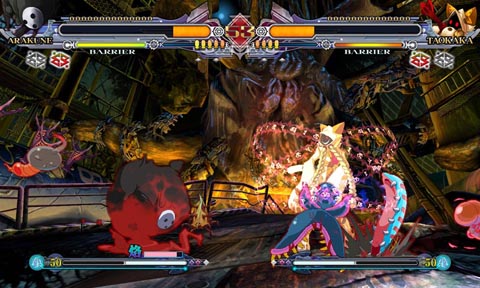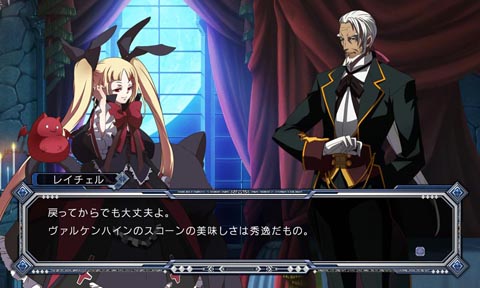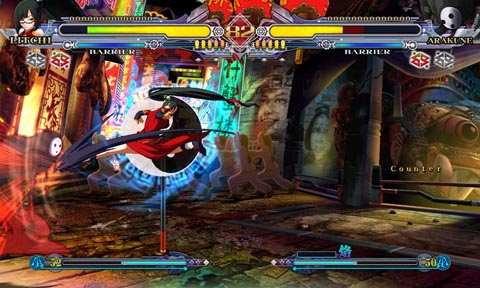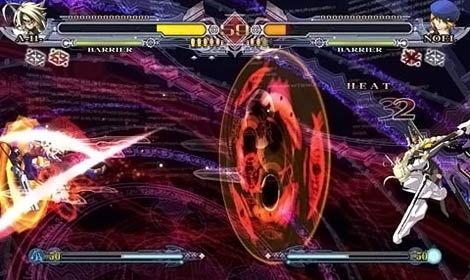Gothic lolita? Check. Cat girl? Check. Mecha musume? Double check! AkSys Games comes back with the next iteration in the BlazBlue franchise, BlazBlue: Continuum Shift. Anyone who has played an Arc System Works fighting game will tell you that every detail has been fine tuned, making the most enjoyable and unique game possible. Continuum Shift is no different and builds upon the success of BlazBlue: Calamity Trigger to bring us yet another quality fighting game.
Presentation
Graphics haven’t changed since the last game and retain the same quality as before. If anything, the whole interface has been improved. Whereas in Calamity Trigger, characters’ unique meters, such as Arakune’s curse meter or Carl’s meter for Nirvana, were represented by a generic red bar below the hit points, these meters are now located above the heat gauge and fit in with the rest of the HUD. Overall, it’s much more polished than Calamity Trigger’s HUD.

Character portraits have also been changed. Continuum Shift’s characters look like they’re straight out of an anime, especially when compared to their Calamity Trigger counterparts. While Calamity Trigger’s art style seemed to blend portraits and anime, Continuum Shift goes full anime, complete with bubbly eyes and an Arakune that’s cuddlier than ever. The only problem with this is that it doesn't really match the tone of the rest of the game now. This is especially noticeable when comparing the likes of Taokaka against her sprite counterpart - complete with fangs and all.
All of the music from Calamity Trigger has also been kept, meaning that fans of Daisuke Ishiwatari’s styling won’t be disappointed. In addition, there are new tracks for the new characters Hazama and Tsubaki, a new opening by KOTOKO, and another character theme titled “Pandora Tears” by Kanako Kondou. More of a good thing never hurt anybody. Selectable tracks means that players can avoid boring tracks they hate or fight to a different track every match. At least players who are having an all-nighter with this game won’t be stuck listening to the same character themes over and over, simply because they’re not switching characters.
Gameplay
Most of the gameplay elements haven’t changed either. It’s still a chain combo based game, meaning that players create combos pushing buttons one after another in an almost free form fashion. This type of free form combo system means that even beginning players will feel competent, easily chaining 15-20 hit combos that look just as impressive.

The other key gameplay feature in the BlazBlue franchise that allows new players to quickly immerse themselves is the Drive button. Aside from the generic A, B, and C attacks, every character has a set of Drive attacks that are done by pressing D, most of which offer the instant gratification other fighting games require dexterity new players lack to execute. Overall, these two play mechanics are what eases the uninitiated into BlazBlue and fighting games, one of the most niche genres in gaming today.
The new beginner’s mode simplifies the whole game, giving players access to canned combos that are executed just by pressing the same buttons repeatedly. However, these pale in comparison to the more intricate combos that players can learn and are nowhere near as useful. Beginner mode is still a fun way for new players to try the game without resorting to mindless and random button mashing.

However, this doesn’t mean that BlazBlue is all easy. Arc System Works is known for making some of the hardest fighting games, namely the Guilty Gear series, and BlazBlue continues that pedigree. Simply mashing random buttons and the Drive attacks will get a player nowhere, except maybe the bottom of the leaderboards on Xbox Live and Playstation Network. Veteran players who put in the time to learn character matchups, damaging combos, and proper spacing will still outclass any rookie player who hasn’t put in the same effort.
So what’s new?
Careful to not make a rehash of Calamity Trigger, the creators changed some basic gameplay systems that will change how players approach Continuum Shift. The most notable change is the Burst system, which is executed by pushing on all four buttons and will push enemies away in the middle of their combo strings. In the previous game, players had one Burst per match, which put them into a danger state when used, taking away access to Barrier block and making the player take more damage. This was somewhat severe and almost discouraged players from using Burst. Continuum Shift gives players one Burst to start off the match, another when they lose a round, and no longer puts them in a danger state. The change is certainly welcome because players are no longer punished for using Burst. At the same time, winning players have to continue their onslaught to win and losing players will get a chance to create some breathing room.

The other change is a shift from a guard meter, which depleted as the player was attacked, eventually leading to a guard break where they’re open for a combo, to the new Guard Primer system. Each character has a set amount of guard primers, while specific moves will destroy them. Once all primers are destroyed, the player’s guard is broken. This is an interesting gameplay mechanic and since only certain moves will destroy primers, players will have to incorporate them into their gameplay. Likewise, players can afford to be more defensive against other moves but will need to be on the lookout for moves like Lambda’s Spike Chaser.
In addition there are two new characters out of the box, Hazama and Tsubaki. They were additions in the arcade version and feature interesting gameplay mechanics. Hazama’s Drive, the Ouroboros, sends out a chain that will allow him to fling across the screen depending on the button pressed after. Tsubaki’s Drive charges up her Install meter, which is needed for any special moves that use the Drive button. A third special character, Mu, must be unlocked, and there are also three more downloadable characters not yet available, which makes for six new characters total. Considering that every character has been unique so far, including Hazama, Tsubaki, and Mu, though there may only be 18 characters total, Continuum Shift’s character variety completely puts other games with over 30 characters to shame.
But alas, this is a fighting game so it's hard to satisfy both hardcore fans and casual players. Hardcore fans want more of the same while casual fans are always asking for new content. For the most part, Arc System Works satisfies both parties, but seeing as how the Burst and Guard Primer system are only noticeable after several playthroughs for casual players, they'll be sure to complain about the lack of gameplay changes.
Helping Scrubs One at a Time

Tutorial mode is something that fighting games have needed for years now, and it’s great to see it included in Continuum Shift. It goes from the basics that everyone should know, such as movement and blocking, to more advanced strategies like spacing and mix-ups. The tutorial consists of a brief set of text instructions followed by a segment where players can try out the new strategies they just learned. If players take these to heart, they can certainly improve and begin to give players more of a challenge.
Challenge mode is the next step for players who want to improve. Much like the DVD that came with the limited edition copy of Calamity Trigger, Challenge mode features tournament combos from top players. Each character has 10 missions total, starting with two that introduce players to the characters’ special moves, Distortion Drives, and Astral Finish. After that, the seven remaining missions are all legit combos that players will likely use during matches. If players can finish all 10 missions and do these combos consistently, they’ll be a force to reckon with.
The best part about the Challenge mode is its demonstration feature. Rather than simply displaying commands and expecting players to perform it, creators included video demonstrations of combos that can be played during Challenge mode. This helps immensely because a column of instructions can be confusing without knowing how the combo should look or time. When are players supposed to press B? The screen is telling me to tap towards twice, but how long should I hold toward? The video demonstration explains all.
Story Mode

Calamity Trigger established the BlazBlue franchise as one of the few fighting games that could have a great story mode and Continuum Shift continues that trend. The story continues after the events of Calamity Trigger and further elaborates on the origins of the characters, like Ragna’s Azure Grimore. The story mode is also full of comical moments, such as when Rachel is unable to show her feelings for Ragna and simply calls him a pedophile instead. These moments really show how colorful BlazBlue’s characters are and allow players to feel closer to them.
Story mode is further enhanced by the great voice acting and script. While Japanophiles and anime otaku will be tempted to turn on Japanese voices instead, reading the English script simply doesn’t do it justice. Rachel’s pompous attitude and English accent come through much better without listening to Japanese voices that most fans won’t understand anyways.
Being Able to Play Someone in New York in my Underwear…Again
Magical. That’s the only way to describe Continuum Shift’s netcode and netplay options. Since it uses the same netcode as its predecessor, players can easily play from coast-to-coast with little problems, barring any connection problems they may have. I was even able to play someone in Japan with relatively smooth results, which is a testament to how much effort and testing the developers have put into this.

In addition, players no longer have to sit in a lobby and wait for players. Instead, they can play in Arcade or Training mode while waiting for players to join the game. Training mode is probably the best option, because it’ll give players a chance to test out and practice combos rather than face off against a mindless AI opponent. It’s amazing how useful this feature is, yet no other fighting game has implemented it before. My hat goes off to Arc System Works for this one.
Arc System Works has done it once again and made the best fighting game to come out this year. Last year, Calamity Trigger was the best designed game and Continuum Shift upholds the legacy with its helpful Tutorial and Challenge modes, immersive Story mode, and magical online components. It not only appeals to hardcore fighting game fans, with its depth, unique characters, and challenging combos, but it eases in new fans with its Drive system and in-depth tutorial and challenge modes that even veteran players can learn from. Continuum Shift is the most complete package that either fighting game fans or casual gamers can get their hands on this year.

